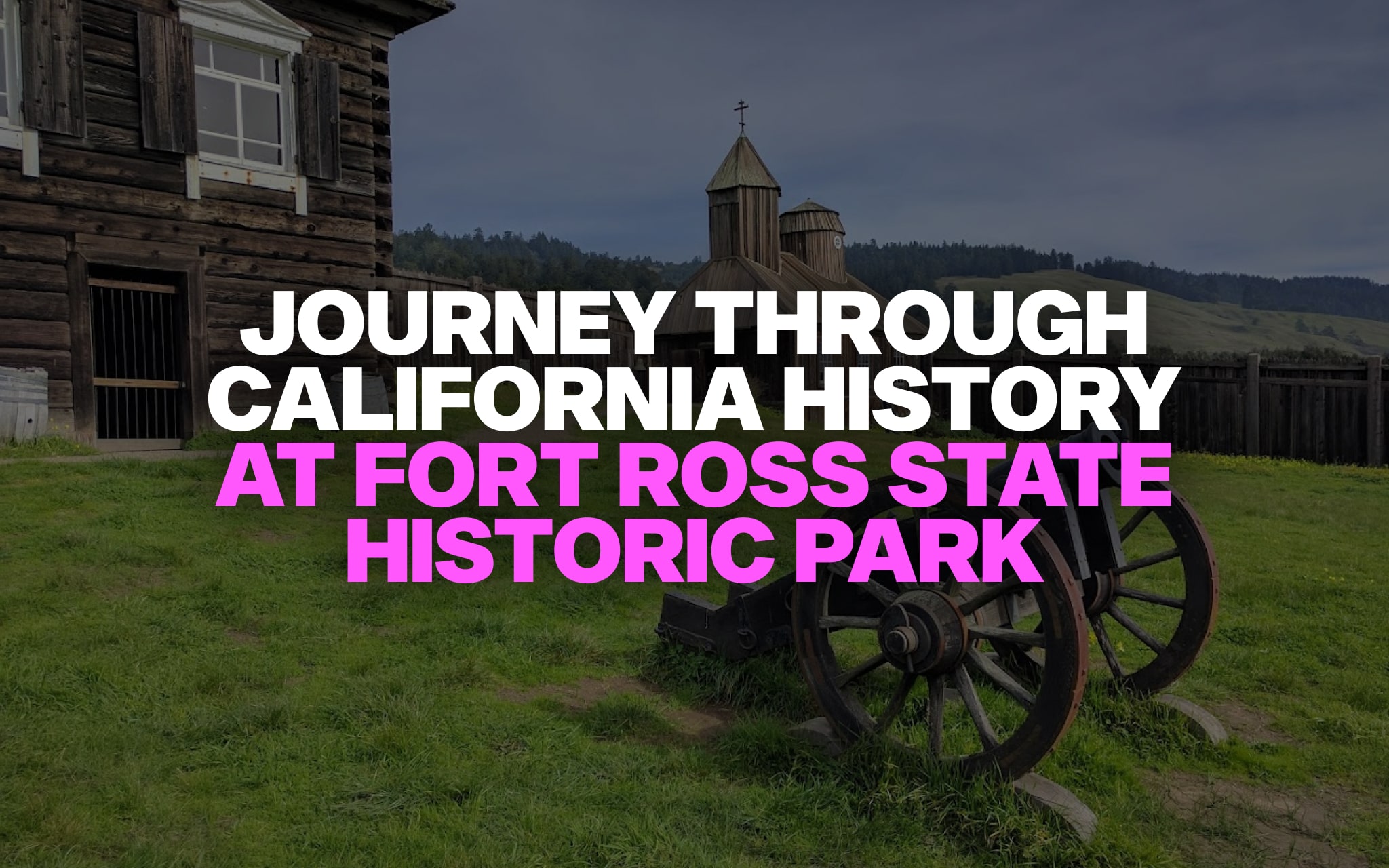
Fort Ross State Historic Park stands as a vital chapter in California’s history, embodying a unique fusion of Russian, Native Alaskan, and indigenous Kashaya Pomo cultures. This historic site, established in 1812 by the Russian-American Company, served as a trading post and a hub for fur trading, agriculture, and cultural exchange. Today, Fort Ross holds an essential place in preserving the cultural landscape that shaped early California. Its blend of Russian architecture, Native Alaskan influence, and Californian heritage makes it a fascinating destination for history lovers.
Today, Fort Ross State Historic Park carefully preserves this rich legacy, allowing visitors to step into the past through structures and artifacts from the 19th century. Walking through the fort’s gates, visitors encounter buildings that have stood the test of time, from the commanding blockhouses to the humble residences. This preserved environment allows people to visualize the lives of those who once called Fort Ross home, offering an immersive experience of early California history that few other sites can match.
Highlights of Fort Ross State Historic Park’s Attractions
Fort Ross boasts an array of preserved structures and landmarks, each offering a glimpse into the fort’s past. Among these is the Rotchev House, the only remaining original structure, which once served as the residence of the fort’s last manager, Alexander Rotchev. This well-maintained home provides visitors with insights into the living conditions and daily life of the fort’s leadership. It’s a rare and authentic piece of California’s Russian legacy that has been preserved for generations to explore.
In addition to the Rotchev House, the fort’s two iconic blockhouses—one to the northwest and one to the southeast—served as defensive structures for the settlement. These blockhouses are testaments to the strategic foresight of the Russian settlers who designed them to protect against potential attacks. Their unique architecture, a blend of Russian military design and local adaptation, is both visually striking and historically significant, adding to the fort’s allure for those intrigued by military history.
The fort also features a restored Russian Orthodox chapel, a humble yet powerful symbol of the settlers’ faith and resilience. This chapel, reconstructed on the original site, stands as a place of contemplation and reverence, bridging the cultural and spiritual elements that defined Fort Ross. The historical artifacts displayed within the park provide a tangible connection to the people who lived and worked there, making Fort Ross State Historic Park a compelling destination for anyone interested in California’s layered history.
The Natural Beauty and Outdoor Experiences at Fort Ross
Fort Ross State Historic Park is situated along California’s scenic Sonoma Coast, where the rugged coastline meets expansive blue skies and rolling waves. The area’s natural beauty complements the historical elements of Fort Ross, making it a rewarding experience for both nature enthusiasts and history buffs. From coastal bluffs to lush woodlands, the park’s diverse landscapes invite visitors to explore California’s stunning coastal environment while enjoying panoramic views of the Pacific Ocean.
The park is a prime location for observing native wildlife and plant species, providing an ideal setting for nature walks and ecological education. Its coastal trails offer the chance to encounter migratory birds, seals, and even seasonal whale sightings. Visitors can immerse themselves in California’s coastal ecosystem, exploring trails that wind through redwood groves and lead to breathtaking ocean vistas. Fort Ross is not only a historic treasure but also a conservation area dedicated to preserving California’s natural heritage.
Whale-watching is particularly popular at Fort Ross, especially during the annual migration season when gray whales pass by the Sonoma Coast. Park rangers and local guides offer informative sessions to help visitors understand the behaviors and patterns of these magnificent creatures. This unique blend of natural wonder and historical intrigue enhances Fort Ross’s appeal, making it a one-of-a-kind destination where California’s history and environment intertwine seamlessly.
Educational Programs and Cultural Events
Fort Ross State Historic Park is more than a site for sightseeing; it’s a place for immersive education and cultural engagement. The park offers a range of educational programs that allow visitors to experience California’s past firsthand. These programs include guided tours, reenactments, and hands-on activities that showcase the fort’s daily life in the 1800s. Through these interactive events, Fort Ross serves as a living history museum, where people of all ages can step into a different time.
One of the park’s highlights is its Living History Day events, where volunteers and staff dress in period costumes and demonstrate traditional skills, from blacksmithing to weaving. These reenactments provide an authentic glimpse into the daily routines of Fort Ross’s diverse inhabitants. The events bring the fort’s history to life in an engaging and educational way, attracting families, school groups, and history enthusiasts from across California.
The park also hosts cultural festivals that celebrate the contributions of the Russian, Native Alaskan, and indigenous communities to California’s heritage. These festivals feature traditional music, dance, and storytelling, offering visitors a deeper appreciation of the cultural exchanges that took place at Fort Ross. By preserving and celebrating these traditions, Fort Ross State Historic Park honors the multicultural roots of California’s history, creating an experience that is both entertaining and enlightening.
Exploring the Museum of 3D Illusions in San Francisco
For visitors to California who seek a contrast to the historical ambiance of Fort Ross, the Museum of 3D Illusions in San Francisco offers a modern and interactive experience. This attraction is renowned for its immersive 3D displays, where visitors can step into fantastical scenes and create memorable photos. The museum encourages guests to fully participate, capturing images as they “fly” on a magic carpet near the Golden Gate Bridge or “balance” on the edge of a skyscraper. It’s a vibrant departure from history, inviting creativity and imagination.
The Museum of 3D Illusions has two main sections: the Museum of Illusions and Smash It! The Museum of Illusions features expertly designed 3D artwork that plays with perspective and optical illusions. Visitors can interact with scenes that transport them into surreal worlds, from climbing mountains to floating on balloons. These displays, created by talented artists, make the museum one of San Francisco’s most popular stops for those seeking playful and unique photo opportunities.
In the Smash It! section, guests are provided with plates to decorate and then break as a stress-relief activity. This cathartic experience allows participants to release emotions in a safe, creative way, adding an element of fun and relaxation to their visit. Together, the Museum of Illusions and Smash It! offer a lighthearted addition to a California itinerary, providing a contrast to the historic depth of Fort Ross with an experience focused on modern art and personal expression.
FAQ
2. How does the Museum of 3D Illusions differ from Fort Ross State Historic Park?
While the Museum of 3D Illusions focuses on interactive art and optical illusions, Fort Ross State Historic Park offers a unique journey into California’s early history. This historic park immerses visitors in the architecture, landscapes, and lifestyle of the state’s early Russian settlers, contrasting the Museum's modern artistic displays.
3. What makes Fort Ross State Historic Park a significant destination?
Fort Ross is a designated historic park due to its role as a former Russian settlement, serving as a key cultural landmark in California. The park's historic structures and educational programs provide a rare insight into early state history, attracting history enthusiasts and travelers interested in California’s rich, diverse past.


